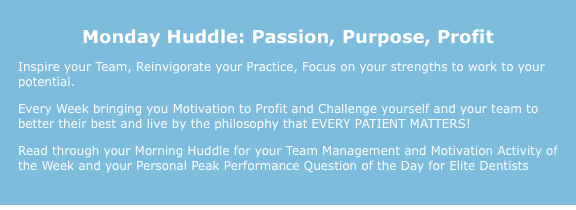I hope you had a wonderful Fourth of July weekend. I have another activity for you. This could very well be the most beneficial game you could ever play and the better you get at it the more influence you will have over your patients to help them say yes to treatment and move forward without hesitation.
Of course, there is another benefit to this as well. Just like our discussion about today instead of tomorrow and to stop procrastinating was good for you also, not just your patients. This one might be even more important for yourself.
Are you ready?
Let’s call this “Is it half full or is it half empty” (otherwise stated as positive or negative minded).
Here’s what I want you to think about for every patient question, every objection, and every comment you make or they make, I want you to think about how you frame and phrase your statements back to them.
Very simply, put do you position it as negative or positive?
For today, you can take three concepts and you can work on them with the exercise I’m about to give you.
First: take several of the most common patient objections and write them down. Whether that is money, insurance, waiting or whatever else.
Second: think about what you wish your patients would do more proactively, such as pay in full, pay in advance, do more dentistry in fewer visits, refer others, say yes faster, etc.
Third: consider every ‘upgrade’ or ‘enhancement’ (what I would call optimal levels of complete health) that you provide that would be seen as something above the minimum.
Now we are going to take these and we are going to create a positive statement for each one of them. We are going to train you first and then the patient to always think of the positive reason why – the glass being half full approach – in order to move forward.
It works almost like flashcards. Let’s take a few obvious ones…
“That seems like a lot of money.” – or anything related to money.
“Well, you are certainly worth it and, best of all, it’s as cheap as it’s ever going to be because you are getting out ahead of this and by being proactive with your health you are actually saving yourself a lot of money in addition to enjoying the benefits for the rest of your life.”
You can take one part of that sentence and it will work just fine.
“I don’t want to do it if my insurance isn’t going to cover it.”
“I can understand your perspective. The challenge is insurance is never going to be of any use to you until you restore your health. Insurance is just designed to help provide you maintenance care. We will be able to bring your health to optimal levels and then insurance will assist with keeping it there.”
There are a half dozen or more different ways to explain insurance’s role. The primary goal is move it back into the positive for the patient.
How about complete treatment… before you even let the patient respond. you say…
“The best news, and what you discussed with the doctor, is that we can combine your treatment into just a couple visits so you won’t have to come back and forth too many times and we’ll be able to get you healthy very quickly.”
It’s about highlighting the positive in your recommendation to the patient. Nothing you would suggest would be detrimental to the patient, but it’s our job to ensure the patients the purpose behind it.
Always remember: anything, and I mean literally anything, a patient says does not mean that they do not want the outcome of the treatment – they most likely DO want to get healthy. They just have to move past their negative tendencies in their mind and give themselves permission to move forward.
It is all about how you describe, explain, address, and reinforce what you are recommending to patients. When you build the habit of framing everything in the positive, you will be amazed at how easy it is to motivate your patients. They are looking for your reassurance and will respond in kind.
Set some time aside this week to play the game. You can each go around and state one positive response or directive that you want to get in the habit of using.
Think about your role and your interaction with your patients, take something that you often hear the patient say (or you catch yourself saying), and work to turn everything to a positive statement for your patients’ benefit.
This is your opportunity to show your leadership, conviction, and confidence in what you are doing which helps guide your patients forward to better health. That is the real power of the positive.



